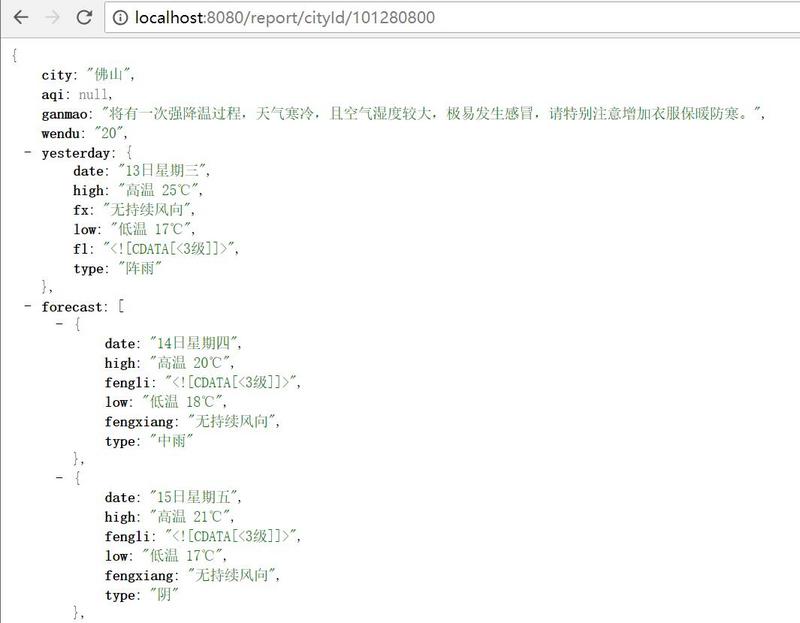API网关 | 从0开始构建SpringCloud微服务(12)
照例附上 项目github链接
本项目实现的是将一个简单的天气预报系统一步一步改造成一个SpringCloud微服务系统的过程。本章主要讲解 API网关 。
项目存在的问题
在目前的项目中我们构建了许多的API微服务,当第三方服务想要调用我们的API微服务的时候是通过微服务的名称进行调用的,没有一个统一的入口。
使用API网关的意义
- 集合多个API
- 统一API入口
API网关就是为了统一服务的入口,可以方便地实现对平台的众多服务接口进行管控,对访问服务的身份进行验证,防止数据的篡改等。
我们的一个微服务可能需要依赖多个API微服务,API网关可以在中间做一个api的聚集。
那么我们的微服务只需要统一地经过API网关就可以了(只需要依赖于API网关就可以了),不用关心各种API微服务的细节,需要调用的API微服务由API网关来进行转发。
使用API网关的利与弊
API网关的利
- 避免将内部信息泄露给外部
- 为微服务添加额外的安全层
- 支持混合通信协议
- 降低构建微服务的复杂性
- 微服务模拟与虚拟化
API网关的弊
- 在架构上需要额外考虑更多编排与管理
- 路由逻辑配置要进行统一的管理
- 可能引发单点故障
API网关的实现
Zuul:SpringCloud提供的API网关的组件
Zuul是Netflix开源的微服务网关,他可以和Eureka,Ribbon,Hystrix等组件配合使用。Zuul组件的核心是一系列的过滤器,这些过滤器可以完成以下功能:
- 身份认证和安全: 识别每一个资源的验证要求,并拒绝那些不符的请求
- 审查与监控:
- 动态路由:动态将请求路由到不同后端集群
- 压力测试:逐渐增加指向集群的流量,以了解性能
- 负载分配:为每一种负载类型分配对应容量,并弃用超出限定值的请求
- 静态响应处理:边缘位置进行响应,避免转发到内部集群
- 多区域弹性:跨域AWS Region进行请求路由,旨在实现ELB(ElasticLoad Balancing)使用多样化
Spring Cloud对Zuul进行了整合和增强。目前,Zuul使用的默认是Apache的HTTP Client,也可以使用Rest Client,可以设置ribbon.restclient.enabled=true。
集成Zuul
在原来项目的基础上,创建一个msa-weather-eureka-client-zuul作为API网关。
添加依赖
<dependency>
<groupId>org.springframework.cloud</groupId>
<artifactId>spring-cloud-starter-zuul</artifactId>
</dependency>
添加注解
添加@EnableZuulProxy启用Zuul的代理功能。
@SpringBootApplication
@EnableDiscoveryClient
@EnableZuulProxy
public class Application {
public static void main(String[] args) {
SpringApplication.run(Application.class, args);
}
}
添加配置
这里配置的是设置路由的url。
当有人访问 /city/ 路径的时候,就对访问这个路径的请求做一个转发,转发到msa-weather-city-eureka服务中去,同理,当有人访问 /data/ 路径的时候,API网关也会将这个请求转发到msa-weather-data-eureka服务中去。
zuul:
routes:
city:
path: /city/**
service-id: msa-weather-city-eureka
data:
path: /data/**
service-id: msa-weather-data-eureka
微服务依赖API网关
原来天气预报微服务依赖了城市数据API微服务,以及天气数据API微服务,这里我们对其进行修改让其依赖API网关,让API网关处理天气预报微服务其他两个微服务的调用。
首先删去原来调用其他两个API微服务的Feign客户端——CityClient以及WeatherDataClient,创建一个新的Feign客户端——DataClient。
package com.demo.service;
import java.util.List;
import org.springframework.cloud.netflix.feign.FeignClient;
import org.springframework.web.bind.annotation.GetMapping;
import org.springframework.web.bind.annotation.RequestMapping;
import org.springframework.web.bind.annotation.RequestMethod;
import org.springframework.web.bind.annotation.RequestParam;
import com.demo.vo.City;
import com.demo.vo.WeatherResponse;
@FeignClient("msa-weather-eureka-client-zuul")
public interface DataClient {
//获取城市列表
@RequestMapping(value="/city/cities",method=RequestMethod.GET)
List<City> listCity()throws Exception;
//通过城市Id查询对应城市的天气数据
@RequestMapping(value="/data/weather/cityId",method=RequestMethod.GET)
WeatherResponse getDataByCityId(@RequestParam("cityId")String cityId);
}
在service中使用该客户端对API网关进行调用,API网关根据我们请求的路径去调用相应的微服务。
@Service
public class WeatherReportServiceImpl implements WeatherReportService{
//@Autowired
//private WeatherDataClient weatherDataClient;
@Autowired
private DataClient dataClient;
//根据城市Id获取天气预报的数据
@Override
public Weather getDataByCityId(String cityId) {
//由天气数据API微服务来提供根据城市Id查询对应城市的天气的功能
WeatherResponse resp=dataClient.getDataByCityId(cityId);
Weather data=resp.getData();
return data;
}
}
在controller也是同理。
//传入城市Id得到对应城市的天气数据
@GetMapping("/cityId/{cityId}")
public Weather getReportByCityId(@PathVariable("cityId")String cityId,Model model)throws Exception{
//获取城市Id列表
//由城市数据API微服务来提供数据
List<City>cityList=null;
try {
cityList=dataClient.listCity();
}catch (Exception e) {
logger.error("Exception!",e);
}
Weather weather=weatherReportService.getDataByCityId(cityId);
return weather;
}
测试结果


- 本文标签: App ACE apache Feign tar 数据 REST springboot 认证 微服务 安全 GitHub http java ribbon https UI Eureka id 测试 Proxy 集群 API src spring Spring cloud git Region list IO 协议 zuul cat 管理 client 虚拟化 springcloud 配置 value Service web Netflix 压力 IDE 开源 Hystrix tab map
- 版权声明: 本文为互联网转载文章,出处已在文章中说明(部分除外)。如果侵权,请联系本站长删除,谢谢。
- 本文海报: 生成海报一 生成海报二











![[HBLOG]公众号](https://www.liuhaihua.cn/img/qrcode_gzh.jpg)

